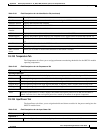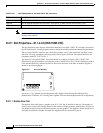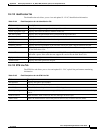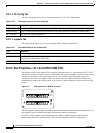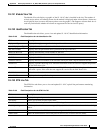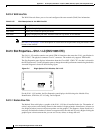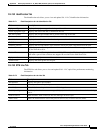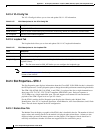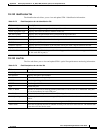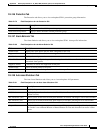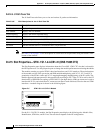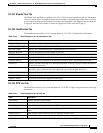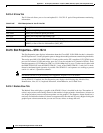
D-163
Cisco Transport Manager Release 7.2 User Guide
78-17630-01
Appendix D Slot Property Information—FC_MR-4, FMEC, Multirate, Optical, and Transponder Cards
Optical Cards
D.4.14.2 Identification Tab
The Identification tab allows you to view and update STM-1 identification information.
D.4.14.3 Line Tab
The Line tab allows you to view and update STM-1 optical line performance monitoring information.
Table D-175 Field Descriptions for the Identification Tab
Field Description
Equipment Type Displays the equipment type the slot is provisioned for.
Actual Equipment Type Displays the actual card that is installed in the slot.
HW Part Number Displays the card part number that is printed on the top of the card.
Hardware Revision Displays the hardware version number of the card.
Serial Number Displays the card serial number that is unique to each card.
CLEI Code Displays the CLEI code.
Firmware Version Displays the revision number of the software used by the ASIC chip installed on the card.
Equipment State Displays the equipment state of the card.
Alarm Profile Sets the alarm profile for the port. Check the Suppress Alarms check box to suppress all alarms
for this card and its port(s).
Table D-176 Field Descriptions for the Line Tab
Field Description
Line Config
Port Number Displays the optical port number.
Port Name Allows you to enter an optical port name.
SD BER Sets the signal degrade bit error rate.
SF BER Sets the signal fail bit error rate.
Type Defines the port.
PJVC-4 Mon# Sets the VC that will be used for pointer justification. If set to 0, no VC is monitored. Only one
VC can be monitored on each STM port.
ProvidesSync If checked, the card is provisioned as an NE timing reference.
EnableSyncMsg Enables synchronization status messages (S1 byte), which allow the node to choose the best timing
source.
Send DoNotUse When checked, sends a DNS (do not use) message on the S1 byte.
Admin State Select the designation that drives whether an entity is in service or out of service. The Admin state
is the driver for the Service state.



